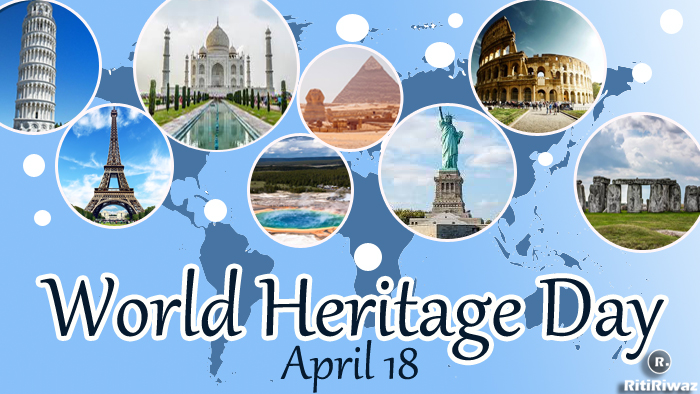World Heritage Day | International Day For Monuments and Sites

World Heritage Day is also known as International Day For Monuments and Sites is observed on 18th April to raise awareness about preserving the history, diversity, and vulnerability of world heritage sites and monuments.
The purpose of celebrating this day is to make people aware of the conservation and importance of these heritage and to attract them to the heritage by giving information about such sites located in different countries of the world. World Heritage Week is celebrated from 19th November to 25th November all over the world.
India is also a land full of historical, religious, natural, and cultural artifacts, memories, and sites. India has a very proud history and the importance of travel. Religious visits often played a big role in the freedom struggle and public awareness. This heritage site has been attracting people from all over the world. Every Indian citizen should be proud of the heritage sites of his country and take steps towards their protection. Even today, more than four thousand religious journeys take place in different contexts in the country. This great travel tradition of India deserves the status of World Heritage.
The theme of World Heritage Day 2024 is “Disasters & Conflicts Through the Lens of the Venice Charter“.
History
World Heritage Day was celebrated for the first time in the world in Tunisia on 18 April 1982. It was organized by the International Council of Monuments and Sites. After this, in the year 1983, it has been decided by UNESCO to celebrate it on 18 April every year. The purpose of World Heritage Day is to emphasize the importance of protecting various sites around the world that have attained World Heritage status.
The World Heritage Site is defined as a natural or man-made area or a structure. Which has international importance and which needs special protection. UNESCO believes that sites classified as World Heritage hold cultural and physical significance. UNESCO World Heritage Sites are designated specific locations (such as forest areas, mountains, lakes, deserts, monuments, buildings, or cities, etc.) that are selected by the World Heritage Sites Committee. And this committee oversees these sites under the auspices of UNESCO. Today, there are a total of 1,092 UNESCO World Heritage Sites worldwide, of which 845 are cultural, 209 natural, and 38 others. 55 of these are under threat, including the birthplace of Jesus, the Church of the Nativity, and the pilgrimage route to Bethlehem.
Each heritage site is the property of the particular country in which that site is located. But it is also in the interest of the international community to protect them for the coming generations and for the benefit of humanity. Rather, the entire world community is responsible for its protection.
Conservation of heritage
Assessment is done by two organizations International Monuments and Sites Council and World Conservation Union to preserve any heritage. It is then recommended to the World Heritage Committee. The committee sits once a year and decides whether to include any nominated property in the World Heritage List. The World Heritage Sites Committee looks after selected special places such as forest areas, mountains, lakes, deserts, monuments, buildings or cities, etc. under the auspices of UNESCO.
On 16 November 1972, the UNESCO General Assembly approved the Convention on Natural and Cultural Heritage of the World, following the 1968 resolution of the International Union for Conservation of Nature, agreed by the United Nations Convention on the Human Environment in 1972 in Stockholm, Sweden. The World Heritage Committee meeting began in June 1977.
Indian heritage sites
For the first time in the year 1983 AD, four historical sites of India were considered by UNESCO as “World Heritage Site”. These four sites were – Taj Mahal, Agra Fort, Ajanta, and Ellora Caves. Today there are many world heritage sites all over India, which are located in different states. UNESCO has included many historical sites of India in the World Heritage List. At present, a total of 35 sites in India are included in the World Heritage List. Out of which 27 have been ranked in the cultural category, 07 in the natural and 01 in the mixed category.
India ranks sixth among the world’s heritage. There are also some countries whose heritage is in danger. These countries include Africa, South America, Europe, etc. A total of 36 percent of the world’s heritage is at risk.
Suggested Read: National Tourism Day
How it is celebrated
World Heritage Day is celebrated in many ways. Visits to sites and monuments are planned with the aim of highlighting the importance of preserving these cultural assets. When the repair work is completed, people are often invited to visit these sites. Extensive media coverage is also done on these things which throw light on the impressive monuments. Interviews and conferences are also held everywhere. Debates and discussions are held and demonstrations for good tableaux are also held. This day is truly a day for every concerned citizen of the country to feel proud of the great cultural wealth of their country.
Objective importance of World Heritage Day
The purpose of celebrating this day is to preserve all the history, culture, and nature-related sites of human history in the whole world and create awareness about it among common people.
An international treaty was proposed by UNESCO of the United Nations, an organization of 193 member countries of the world, committed to the preservation of all the natural and social heritage of the world. There are 21 member countries signing this proposal. The first proposal of this World Heritage Treaty was put in the year 1972, UNESCO included three lists of World Heritage Sites, which are as follows.
- Natural Heritage Site
- Cultural heritage site
- Mixed Heritage Site
The main objective of celebrating this event is that the main goal was to preserve the heritage of the three categories for the next generation and put its relevant efforts in front of the world.
As of 2015, 1031 sites around the world have been included in the World Heritage Site by UNESCO. These sites are given the World Heritage Fund by UNESCO. All these sites have 802 cultural categories, 197 natural sites, and 32 mixed sites. World Heritage Day is celebrated to create awareness about these sites of the world.
World Heritage Site of India
Such heritage sites are listed by UNESCO in different countries of the world. Italy has the largest number of World Heritage Sites in the world, numbering 51. Apart from this, 48 in China, 44 in Spain. 41 in France, 40 in Germany, 33 in Mexico, 32 such sites in our country India have been included in the World Heritage List. There are 25 cultural sites and 7 natural sites.
Religious journeys in India for thousands of years have been revered as ideals, values of life, social reform, philosophical and tradition of renunciation. Rarely, religious visits should not contribute to the life stage of hardly any saint of India. Gautam Buddha, Mahavira, Gurunanak, Shankaracharya, and Mahatma Gandhi have all been very important in their lives. Whether these trips were done to give new life to the society, whether these trips were done for the promotion of religion or to awaken the ‘Vasudhaiva Kutumbakam’ or whether these trips were an emotional attempt to connect one end of the country to the other. There is no addition or option for such trips anywhere else in the world.
Agra Fort, Ajanta Caves, Sanchi Stupas, Champaner-Pandavgarh Bagh, Chhatrapati Shivaji Terminal, Old Goa Church, Elephanta Caves, Ellora Caves, Fatehpur Sikri, Chola Temples, Hampi Memorials, Mahabalipuram Monuments, Pattadakkal Memorials, Humayun’s Tomb, Kaziranga, Nandadevi and Valley of Flowers, Keoladeo, Manas Sundarbans National Sanctuary, Taj Mahal, Indian Mountain Rail, Khajuraho, Mahabodhi Temple, Bhimbetka, Sun Temple of Konark, Qutub Minar, etc. sites of India have been included in the World Heritage List.






